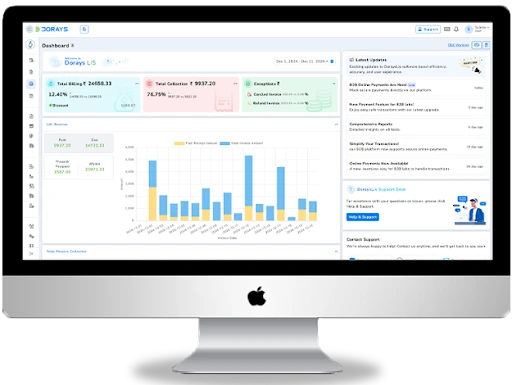Radiology
Radiology remains one of the most indispensable elements of modern healthcare. Yet, small clinics often face challenges with radiology reporting due to high patient volumes, limited resources, and outdated tools. Lengthy reporting timelines can strain healthcare professionals and lead to delays in patient care.
With AI-integrated radiology software, these pain points are being addressed head-on. This blog explores how AI-powered Radiology Information Systems (RIS) are transforming radiology workflows, enabling clinics to reduce reporting time and improve diagnostics. By the end, you'll know exactly how to supercharge your clinic's radiology operations.
What is AI-Integrated Radiology Software?
Before exploring its benefits, let's define AI-integrated radiology software, also known as an AI-driven RIS.
Radiology Information Systems (RIS) are essential for managing the clinical and administrative workload of radiology departments. When paired with Picture Archiving and Communication Systems (PACS), RIS serves as the backbone for streamlining data flow, imaging, and reporting. By integrating Artificial Intelligence into RIS platforms, the system becomes smarter and more efficient, offering intelligent automation and analysis.
How Does it Work?
- Data Collection and Analysis - AI analyses patient data, including imaging and clinical history, for quicker insights.
- Workflow Automation - Tasks like patient scheduling, imaging prioritisation, and report generation are automated, reducing manual intervention.
- Decision Support - AI scans radiological images for patterns and abnormalities, providing radiologists with faster, accurate suggestions backed by data.
The result? A seamless system that combines automation with expert-level insights, all designed to improve efficiency across every step of the radiology workflow.
Benefits of AI in Radiology Reporting
The integration of AI into radiology software brings game-changing benefits for clinics and healthcare professionals. Here's how it achieves faster, more accurate reporting:
1. Reduced Reporting Time
AI systems can process imaging data in seconds, cutting report turnaround time drastically. For example:
- Automated Image Analysis reduces the need for initial manual reviews.
- Instant Annotations and Highlights identify areas of concern, allowing radiologists to focus on evaluating the most critical elements.
Clinics using AI radiology reporting software often experience up to 30–40% faster turnaround times compared to traditional methods.
2. Improved Accuracy and Reliability
AI's ability to detect patterns in imaging data goes beyond human limitations. This enhances:
- Diagnoses by identifying abnormalities such as tumours or fractures that may not be immediately detected by the human eye.
- Minimising Errors in reports, as machine learning algorithms are fine-tuned to catch subtle discrepancies.
This precision elevates the quality of care for patients.
3. Enhanced Workflow Efficiency
The automation capabilities of AI-driven tools free clinic staff from repetitive, time-consuming tasks, such as:
- Manually inputting patient data
- Tracking patient imaging requests
- Generating preliminary reports
This optimised workflow enables radiology departments to handle higher volumes of work without requiring additional resources.
4. Streamlined Communication
Collaboration across care teams improves when reports generated via AI radiology software are:
- Digitally accessible to all stakeholders.
- Linked seamlessly to patient records for efficient follow-ups.
Radiology staff and referring physicians can work together more efficiently toward better health outcomes.
Real-World Applications of AI Radiology Software
Case Study 1: A Small Clinic in Birmingham
Birmingham Radiology Centre implemented AI radiology software into their existing reporting system. Within six months, they saw:
- A 40% reduction in report turnaround time.
- Increased capacity to handle 25% more patient cases daily.
- Positive feedback from referring physicians on report accuracy.
Case Study 2: A Private Practice in Edinburgh
A radiology lab in Edinburgh integrated AI-based RIS and PACS to streamline operations. Results included:
- 15% reduction in imaging errors thanks to automated quality assurance checks.
- Faster scheduling and follow-ups, cutting appointment wait times by half.
- Doctors reporting higher confidence in AI-aided diagnostic support.
These examples demonstrate how AI radiology systems can optimise performance even in resource-constrained clinics.
Choosing the Right AI-Integrated RIS for Your Clinic
Investing in AI radiology software is a significant decision. Here are key considerations to ensure you select the right solution for your clinic:
1. Scalability
Make sure the software scales as your clinic grows. Cloud-based AI radiology systems are particularly useful, as they expand storage and processing capacity without requiring new hardware.
2. Automation Features
Consider solutions that offer automated workflows for report generation, task prioritisation, and data management.
3. Integration Capabilities
The AI radiology software should integrate seamlessly with existing systems like PACS, hospital information systems (HIS), and electronic medical records (EMR).
4. Regulatory Compliance
Ensure the software adheres to healthcare laws like GDPR or HIPAA, safeguarding patient data.
5. Support and Training
Check whether the vendor offers training and ongoing support to help your staff maximise the software's potential.
Supercharge Radiology Reporting in Your Clinic Today
The challenges of radiology reporting are clear, but so are the solutions. By adopting AI-integrated radiology software, clinics can unlock faster reporting times, improved diagnostics, and greater operational efficiency.
Investing in these advancements doesn’t just benefit clinicians but directly impacts patient care, enabling faster treatment and better health outcomes.
Want to see it in action? Request a personalized demo today and discover how AI-powered radiology software can transform your clinic.

